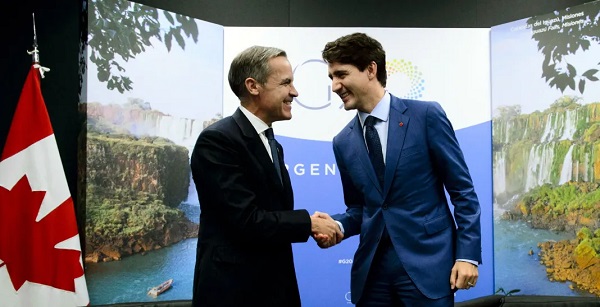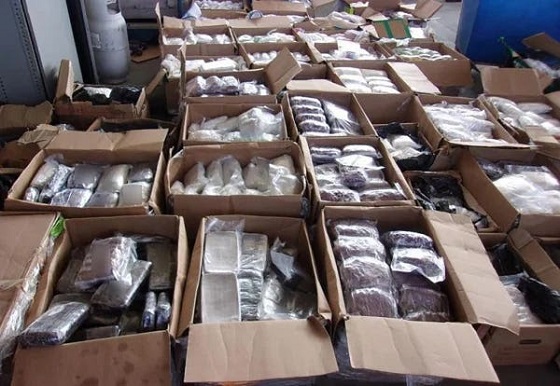Uncategorized
Hundreds attend vigil to honour 20 victims of limousine crash

AMSTERDAM, N.Y. — A ceremony for the victims of the limousine crash that killed 20 people ended with participants lifting candles above their heads to signal unity and perseverance.
Over 1,000 people jammed a riverside park in Amsterdam, New York, for Monday night’s vigil as victims’ relatives tried to come to grips with the tragedy that happened as a group of friends and family were on their way to a 30th birthday party.
The supersized limo ran a stop sign and hit a parked SUV on Saturday in Schoharie (skoh-HAYR’-ee).
Authorities have yet to say how fast the limo was going or determine why it failed to stop and sped off the road at the bottom of a long hill.
The 19-seat vehicle had at least some seat belts, but it was unclear whether anyone was wearing them, National Transportation Safety Board Chairman Robert Sumwalt said.
The crash about 170 miles north of New York City came three years after another deadly stretch-limo wreck in New York state spurred calls for Gov. Andrew Cuomo to examine such vehicles’ safety. There is no evidence the state took any steps to do so.
Some relatives of the dead shed tears as local officials expressed solidarity with them.
U.S. Rep. Paul Tonko, a Democrat from Amsterdam, told a crowd that spilled onto a bridge spanning the Mohawk River, “We are crushed with you, we are crushed for you.”
Some relatives shed tears as a woman sang “Amazing Grace.” The ceremony ended with everyone lifting their candles above their heads in unity.
The wreck killed two pedestrians and all 18 people in the limousine, including four sisters who were headed with friends and relatives to a brewery for a party for one of the sisters.
The four sisters’ aunt, Barbara Douglas, said they had felt “they did the responsible thing getting a limo so they wouldn’t have to drive anywhere.”
“My heart is sunken. It’s in a place where I’ve never felt this type of pain before,” said Karina Halse, who lost her 26-year-old sister Amanda.
Authorities haven’t released the driver’s name, but friends and relatives identified him on social media as Scott Lisinicchia.
“The investigation is STILL going on and the facts are not verified,” his niece, Courtney Lisinicchia, wrote on Facebook.
The state moved to shut down the owner, Prestige Limousine, as state and federal authorities investigated the cause of Saturday’s wreck in Schoharie. The company said it was taking its cars off the road while conducting its own probe into the crash.
Investigators plan to examine the mangled limo’s data recorders and mechanical systems as well as the road, which has a history as a danger spot. They are also looking into the driver’s record and qualifications and conducting an autopsy to see if drugs or alcohol were factors.
But officials already saw some red flags, Cuomo said: The driver didn’t have the necessary commercial license, and the vehicle failed a state inspection that examined such things as the chassis, suspension and brakes.
“In my opinion, the owner of this company had no business putting a failed vehicle on the road,” the governor said while attending a Columbus Day Parade in New York City. “Prestige has a lot of questions to answer.”
He also said the limo — built by cutting apart a heavy-duty SUV and lengthening it — had been created without federal certification, though NTSB officials said they hadn’t yet determined whether the vehicle met federal standards.
Prestige Limousine issued a statement Monday expressing condolences to victims’ families and saying it was conducting “a detailed internal investigation” while also meeting with state and federal authorities.
The Gansevoort, New York-based company said it pulled its cars from the road voluntarily. But state police say they seized four Prestige cars, including the one that crashed.
Federal records show the company has undergone five inspections in the past two years and had four vehicles pulled from service.
In inspections Sept. 4, the company’s limos were cited for defective brakes, lack of proper emergency exits, flat or balding tires, defective windshield wipers, and other maintenance problems.
An attorney for Prestige said Tuesday the safety violations were fixed before Saturday’s wreck. Lee Kindlon told CBS News he doesn’t think the recent infractions contributed. He told the Times Union of Albany the driver may have been unfamiliar with the roadway.
Federal transportation records show Prestige is owned by Shahed Hussain, who worked as an informant for the FBI after the Sept. 11 attacks, infiltrating Muslim groups by posing as a terrorist sympathizer in at least three investigations. In one case, he helped convict men accused of plotting to bomb New York synagogues.
His role at the FBI was assailed by civil liberties groups, who accused him of helping the FBI entrap people. Asked Monday about Hussain, the FBI wouldn’t comment.
The limousine, built from a 2001 Ford Excursion, ran a stop sign at a T-shaped intersection at the bottom of a hill and slammed into an unoccupied SUV.
Investigators have yet to determine whether the driver tried to brake. The crash left no visible skid marks, but that might be due to misty weather or anti-lock brakes, Sumwalt said.
The crash appeared to be the deadliest land-vehicle accident in the U.S. since a bus full of Texas nursing home patients fleeing 2005’s Hurricane Rita caught fire, killing 23. Saturday’s wreck was the nation’s deadliest transportation accident of any kind since a 2009 plane crash near Buffalo, New York, killed 50 people.
Factory-built limousines must meet stringent safety regulations. But luxury cars converted to limos, like the one in Saturday’s crash, often lack such safety components as side-impact air bags, reinforced rollover protection bars and accessible emergency exits.
Few federal regulations govern limos modified after leaving the factory. Regulations often vary by state.
“It certainly is the Wild West out there when it comes to limousines and stretch vehicles,” said National Safety Council CEO Deborah A.P. Hersman.
Ford said in a statement that it has never made its own stretch version of the Excursion. It did certify outside companies to modify them to Ford specifications for up to 14 seats during the 2001 model year, but it wasn’t clear who modified the SUV that crashed Saturday.
After a stretch limousine was T-boned on New York’s Long Island in 2015, killing four women, a special grand jury implored Cuomo to examine the safety of such vehicles.
It appears the task force was never formed, and nearly three years after the grand jury’s recommendation, it was unclear what, if anything, Cuomo’s administration did in response.
“I don’t know if there was a task force set up,” the governor said Monday, while suggesting that Saturday’s crash didn’t necessarily point to a need for more regulation.
“Sometimes, people just don’t follow the law” that already exists, he said. “And that may very well be what happened here.”
The New York grand jury report recommended state lawmakers require stretch limousines that seat nine or more passengers to meet the stricter inspection regulations that apply to buses.
Lawmakers, including Democratic Sen. Chuck Schumer of New York, asked federal officials several years ago to raise safety standards for stretch limos modified after manufacture.
___
Caserta reported from New York. Contributing to this report were Associated Press writers Michael Balsamo, Jennifer Peltz and Jim Mustian in New York; Mary Esch in Latham, N.Y.; David Klepper in Albany, N.Y.; and AP Auto Writer Tom Krisher in Detroit.
Michael Hill And Sabrina Caserta, The Associated Press
Uncategorized
Cost of bureaucracy balloons 80 per cent in 10 years: Public Accounts

The cost of the bureaucracy increased by $6 billion last year, according to newly released numbers in Public Accounts disclosures. The Canadian Taxpayers Federation is calling on Prime Minister Mark Carney to immediately shrink the bureaucracy.
“The Public Accounts show the cost of the federal bureaucracy is out of control,” said Franco Terrazzano, CTF Federal Director. “Tinkering around the edges won’t cut it, Carney needs to take urgent action to shrink the bloated federal bureaucracy.”
The federal bureaucracy cost taxpayers $71.4 billion in 2024-25, according to the Public Accounts. The cost of the federal bureaucracy increased by $6 billion, or more than nine per cent, over the last year.
The federal bureaucracy cost taxpayers $39.6 billion in 2015-16, according to the Public Accounts. That means the cost of the federal bureaucracy increased 80 per cent over the last 10 years. The government added 99,000 extra bureaucrats between 2015-16 and 2024-25.
Half of Canadians say federal services have gotten worse since 2016, despite the massive increase in the federal bureaucracy, according to a Leger poll.
Not only has the size of the bureaucracy increased, the cost of consultants, contractors and outsourcing has increased as well. The government spent $23.1 billion on “professional and special services” last year, according to the Public Accounts. That’s an 11 per cent increase over the previous year. The government’s spending on professional and special services more than doubled since 2015-16.
“Taxpayers should not be paying way more for in-house government bureaucrats and way more for outside help,” Terrazzano said. “Mere promises to find minor savings in the federal bureaucracy won’t fix Canada’s finances.
“Taxpayers need Carney to take urgent action and significantly cut the number of bureaucrats now.”
Table: Cost of bureaucracy and professional and special services, Public Accounts
| Year | Bureaucracy | Professional and special services |
|
$71,369,677,000 |
$23,145,218,000 |
|
|
$65,326,643,000 |
$20,771,477,000 |
|
|
$56,467,851,000 |
$18,591,373,000 |
|
|
$60,676,243,000 |
$17,511,078,000 |
|
|
$52,984,272,000 |
$14,720,455,000 |
|
|
$46,349,166,000 |
$13,334,341,000 |
|
|
$46,131,628,000 |
$12,940,395,000 |
|
|
$45,262,821,000 |
$12,950,619,000 |
|
|
$38,909,594,000 |
$11,910,257,000 |
|
|
$39,616,656,000 |
$11,082,974,000 |
Uncategorized
Trump Admin Establishing Council To Make Buildings Beautiful Again


From the Daily Caller News Foundation
By Jason Hopkins
The Trump administration is creating a first-of-its-kind task force aimed at ushering in a new “Golden Age” of beautiful infrastructure across the U.S.
The Department of Transportation (DOT) will announce the establishment of the Beautifying Transportation Infrastructure Council (BTIC) on Thursday, the Daily Caller News Foundation exclusively learned. The BTIC seeks to advise Transportation Secretary Sean Duffy on design and policy ideas for key infrastructure projects, including highways, bridges and transit hubs.
“What happened to our country’s proud tradition of building great, big, beautiful things?” Duffy said in a statement shared with the DCNF. “It’s time the design for America’s latest infrastructure projects reflects our nation’s strength, pride, and promise.”
“We’re engaging the best and brightest minds in architectural design and engineering to make beautiful structures that move you and bring about a new Golden Age of Transportation,” Duffy continued.
Mini scoop – here is the DOT’s rollout of its Beautifying Transportation Infrastructure Council, which will be tasked with making our buildings beautiful again. pic.twitter.com/
9iV2xSxdJM — Jason Hopkins (@jasonhopkinsdc) October 23, 2025
The DOT is encouraging nominations of the country’s best architects, urban planners, artists and others to serve on the council, according to the department. While ensuring that efficiency and safety remain a top priority, the BTIC will provide guidance on projects that “enhance” public areas and develop aesthetic performance metrics.
The new council aligns with an executive order signed by President Donald Trump in August 2025 regarding infrastructure. The “Making Federal Architecture Beautiful Again” order calls for federal public buildings in the country to “respect regional architectural heritage” and aims to prevent federal construction projects from using modernist and brutalist architecture styles, instead returning to a classical style.
“The Founders, in line with great societies before them, attached great importance to Federal civic architecture,” Trump’s order stated. “They wanted America’s public buildings to inspire the American people and encourage civic virtue.”
“President George Washington and Secretary of State Thomas Jefferson consciously modeled the most important buildings in Washington, D.C., on the classical architecture of ancient Athens and Rome,” the order continued. “Because of their proven ability to meet these requirements, classical and traditional architecture are preferred modes of architectural design.”
The DOT invested millions in major infrastructure projects since Trump’s return to the White House. Duffy announced in August a $43 million transformation initiative of the New York Penn Station in New York City and in September unveiledmajor progress in the rehabilitation and modernization of Washington Union Station in Washington, D.C.
The BTIC will comprise up to 11 members who will serve two-year terms, with the chance to be reappointed, according to the DOT. The task force will meet biannually. The deadline for nominations will end Nov. 21.
-

 Business1 day ago
Business1 day agoFederal major projects list raises questions
-

 Artificial Intelligence16 hours ago
Artificial Intelligence16 hours agoTrump’s New AI Focused ‘Manhattan Project’ Adds Pressure To Grid
-

 International1 day ago
International1 day agoAmerica first at the national parks: Trump hits Canadians and other foreign visitors with $100 fee
-

 Artificial Intelligence2 days ago
Artificial Intelligence2 days agoGoogle denies scanning users’ email and attachments with its AI software
-

 Indigenous2 days ago
Indigenous2 days agoCanadian mayor promises to ‘vigorously defend’ property owners against aboriginal land grab
-

 COVID-192 days ago
COVID-192 days agoCrown seeks to punish peaceful protestor Chris Barber by confiscating his family work truck “Big Red”
-

 Business1 day ago
Business1 day agoBlacked-Out Democracy: The Stellantis Deal Ottawa Won’t Show Its Own MPs
-

 International7 hours ago
International7 hours agoAfghan Ex–CIA Partner Accused in D.C. National Guard Ambush










